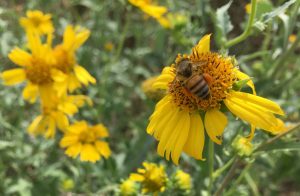In response to the coronavirus stay-at-home quarantine, people are moving outside to garden and relieve stress. “Resilience gardens” are taking root across the country–gardens that recall the victory gardens of the World Wars and inspire self-sufficiency.
Resilience gardens typically comprise food, herbs, and ornamental plants, said Brandon Kirby, partner and second-generation nurseryman at the independently owned Rainbow Gardens in San Antonio, Texas. Kirby and his team recently launched a “resilience gardening” initiative in response to corona virus stay home, work safe and social distancing guidelines.
Growing fruits and vegetables can make people feel self-sufficient, said Kirby, while herbs have culinary, medicinal, and aromatherapy uses. And cultivating ornamentals provides an outlet for individuals to unwind.

Native bee on fennel flowers. Photo by Monika Maeckle
Many scientific studies prove the mental and physical benefits of gardening. They cite the rearing of fruits and vegetables resulting in a mild feeling of control, the peace of mind that can occur in a backyard, and how digging, weeding, watering and just being outside can restore people and get them away from their screens and drama of the daily news. One study detailed how exposure to soil is good for health by creating contact with outdoor microbes that can boost the immune system.
Given that insect and wildlife pollinators make one out of every three bites of our food possible, one could argue resilience gardens should also cater to pollinators. The addition of pollinator habitat can help boost yields of food and provide another dimension of stress relief–the calming effect of observing bees, butterflies and hummingbirds carry on nature’s cycles.
“The normalcy of the seasonal changes in my garden has helped me feel better about our current situation,” said Lee Marlowe, president of the Native Plant Society of Texas San Antonio chapter. “Native plant gardening is one of the best ways I find to connect with nature and its seasonal rhythms which is good for the soul, especially during stressful times.”
Witnessing seasonal routines can be comforting and powerful, she added, as well as “bringing a sense of normalcy to the otherwise strange and challenging situation we find ourselves in,” she said.
Charles Bartlett, president of Green Haven Industries in San Antonio, has been gardening for 75 years. Now 81, the Army veteran gardened at the knee of his grandmother as a preschooler.

Honeybee on Cowpen daisy, a member of the Aster family. Photo by Monika Maeckle
“She viewed Mother Nature as her ‘doctor’ with calming influences, huge stress relief, and each year providing hope for the future,” Bartlett said. “She lived a sickness-free life until she was 96.
“Today, our stresses are somewhat different, but through my long life, I have met thousands of gardeners who say, ‘Gardening saved my life!’ This is the time to get outside, create something beautiful, and re-establish our age-old communion with nature.”
Apart from the reassurance of seasonality, making your resilience garden pollinator friendly can also boost crop yields, studies show.
Elizzabeth Kaufman of the Pollinator Partnership suggests including bright native floral displays to attract pollinators like bees, butterflies, hummingbirds, and other beneficial insects to the garden. Such additions will “increase visitation to and the pollination of your garden plants” that require pollination services to produce fruit and vegetables, she said.
Incorporating native plants into garden areas will also attract other beneficial predatory insects that eat garden pests, such as aphids, she added.
Kaufman advises that plant selection should be directed by geographic location.
Powerhouse pollinator plants like native milkweeds, sages, sunflowers and coneflowers will work best when chosen with ecoregion specific species in mind.
The Pollinator Partnership has free downloadable Ecoregional Planting Guides that provide specific recommendations for plants along with other valuable information on pollinators and creating habitat for them. Just type in your zip code and custom recommendations for your ecoregion will appear.
Another good resource: Best edibles for pollinators, a great list assembled by the folks at garden resource company, GrowVeg. Also check out our Resources page.
TOP PHOTO: Want more homegrown tomatoes? Add pollinator habitat to get the bumblebees into your yard. Photo by Monika Maeckle
Related posts:
- We did it! San Antonio pollinator habitat hits 510 by 2020
- Cowpen daisy: Unofficial pollinator plant of the year 2019
- How to plan a successful butterfly garden
- Mostly native butterfly garden outperforms lawn every time
- Downtown River walk plot converts to pollinator garden, creature haven
- Converting your Lawn to a Butterfly Garden
- A year in the life of an urban butterfly garden
Like what you’re reading? Don’t miss a single post from the Texas Butterfly Ranch. Sign up for email delivery, or follow us on Facebook, Twitter, or Instagram.


Great article at times like these, so much uncertainty. The great outdoors is calling. Can I share this article?
OF course!
Monika:
This is a wonderful article considering the trying times our nation is experiencing. I hope significant numbers of readers read this article and consider your suggestions. It would be nice if the article received national exposure.
Byron